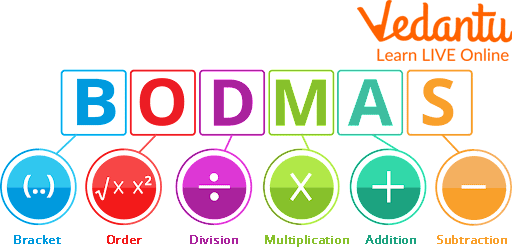




Overview of Numerical Expressions
Simplifying expressions means rewriting the same algebraic expression with no like terms and in a compact manner. To simplify expressions, we combine all the like terms and solve all the given brackets, if any, and then in the simplified expression, we will be only left with unlike terms that cannot be reduced further.
In this article, we will learn a bunch of things. We will understand what numerical means in Maths and get to know more through numerical expression examples. We will learn the popular BODMAS rule that is used to simplify numerical expressions.
Numerical Expression Examples
A numerical expression consists of only numbers or integers. It includes basic mathematical operations such as addition, subtraction, multiplication, or division. Therefore, a numerical expression can be defined as a combination of numbers or integers and mathematical operators.
Example: k (16 - k) + 8 (16 - k), 9 (15 - k) = 145, etc.
What Does It Mean to Simplify Numerical Expressions?
Simplifying a numerical expression means solving it in the simplest way possible. Simplification refers to reducing complex expressions into simple Maths numerical that can be solved easily with basic arithmetics.
There are a bunch of things that you need to take care of while simplifying an expression such as the BODMAS rule, removing brackets, ordering from left to right, etc. Let us learn all of them, one by one.
Rule of BODMAS
The rule of BODMAS is one of the popular concepts in the field of algebra. The term BODMAS is an acronym. It stands for Brackets, Order, Division, Multiplication, Addition, and Subtraction. The acronym tells you the order in which you need to simplify the expression.

Full Form of BODMAS
Firstly, you need to resolve the brackets. The second preference is for orders or exponents. Then you have to do the division or multiplication in order from left to right, whichever comes first. Similarly, in the end, you must solve addition or subtraction, from left to right, whichever operation comes first.
Example: 5 x 8 - 12 ÷ 6 + 4\[^{2}\]
Ans: First of all we will solve the square of 4. i.e. 16.
= 5 x 8 - 12 ÷ 6 + 16
Now as per the BODMAS rule, first of all, the division will be done, then multiplication. So, the equation will become
= 40 - 2 + 16
Now the addition and subtraction will be done in the next step, which will give the result as:
= 56 - 2
= 54
Types of Brackets Used in Expressions
Generally, three types of brackets are used in a numerical expression and are very important while knowing how to simplify expressions.
The First Bracket is Parentheses, which is denoted by ( ).
The Second Bracket is the Curly Bracket, which is denoted by { }.
The third Bracket is the Square Bracket, which is denoted by $\left[ \right]$.
The rule in the bracket classification is that the operation in the first bracket needs to be performed first. Then the second bracket and finally, the third.
If you are confused with all these rules, you need not worry. We have got some solved examples for you to understand the concepts better.
Solved Examples
Go through these two solved examples to understand how the BODMAS rule is applied while simplifying the numerical expression calculator. Also, notice how the brackets are removed with priority. Below are some examples of numerical expressions with answers:
Example 1: $[8+\{6-(6 \div 2)\}] \times 4$
Ans: First of all-round brackets will be removed
$=[8+\{6-3\}] \times 4$
Then, curly brackets will be removed
$=[8+3] \times 4$
In the end, Square brackets will be removed
$=11 \times 4$ $=44$
Example 2: $12+[16-\{6+(4 \div 2)\}]$
Ans: First of all-round brackets will be removed
$=12+[16-\{6+2\}]$
Then, curly brackets will be removed
$=12+[16-8]$
In the end, Square brackets will be removed
$=12+8$
$=20$
Practice Questions
Simplify numerical expressions given below:
Q1. 15 × 3 - 15 ÷ 3
Ans: 40
Q2. $64-[\{48 \div 6\} \times 4]+8$
Ans: 40
Q3. $(9 \div 3) \times 7-5 \times 4$
Ans: 1
Q4. $22-\{8+(6 \div 2)\}$
Ans: 11
Summary
Firstly, we learned what numerical expressions are, with the help of some examples. The major focus of the article was on the important topic of simplification of numerical expressions for Class 5. We understood the types of brackets used in these expressions.
We also got to know about the BODMAS rule and learned how to use it to simplify complex expressions by going through some solved examples. If an expression is simplified without using the BODMAS rule, you might still get an answer but it will be incorrect. Therefore, it is necessary to follow the BODMAS rule carefully.
FAQs on Simplification of Numerical Expressions
Q1. What is the PEMDAS rule?
Ans: The PEMDAS rule is similar to the BODMAS rule. In India and the UK, what we know as the BODMAS rule is called the PEMDAS rule in the US. It stands for Parentheses, Exponents, Multiplication, Division (from left to right), Addition, and Subtraction (from left to right).
Q2. Can power be expressed as a numerical expression?
Ans: Power has two parts: an exponent and a base. Yes, it can be expressed as a numerical expression. For example, 2 raised to power 3 is nothing but 3 times the number 2. Therefore, it can be expressed as 2 × 2 × 2.
Q3. How do simplifying expressions and solving equations differ?
Ans: Equations refer to those statements that have an equal to "=" sign between the term(s) written on the left side and the term(s) written on the right side. Solving equations means finding the value of the unknown variable given. On the other hand, simplifying expressions means only reducing the expression to its lowest form. It does not intend to find the value of an unknown quantity.











